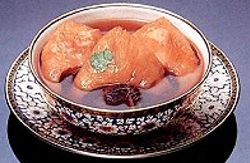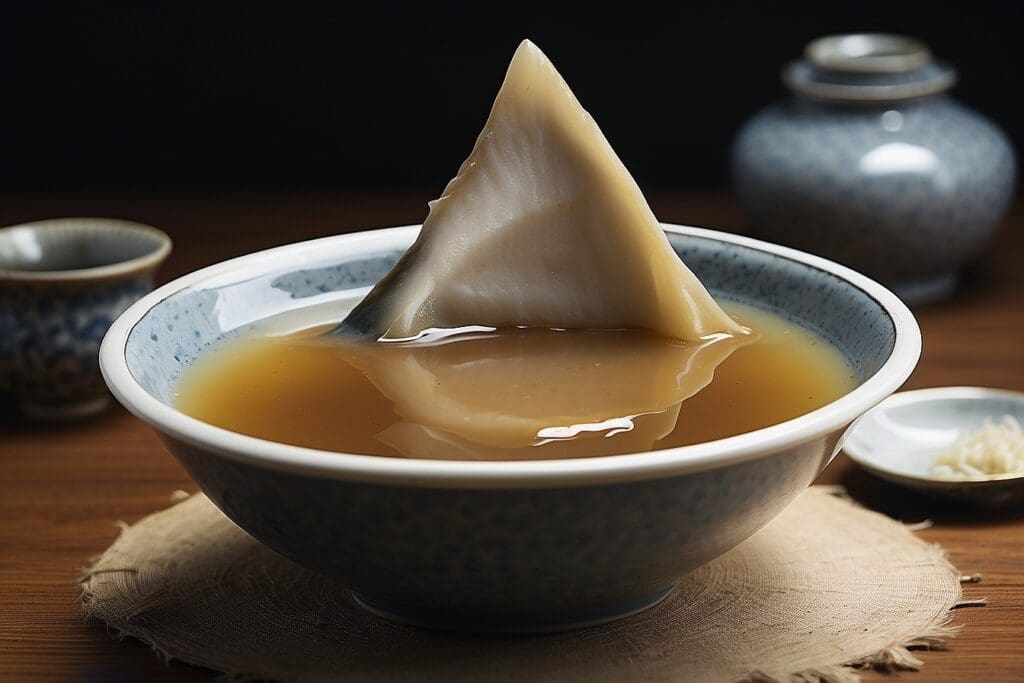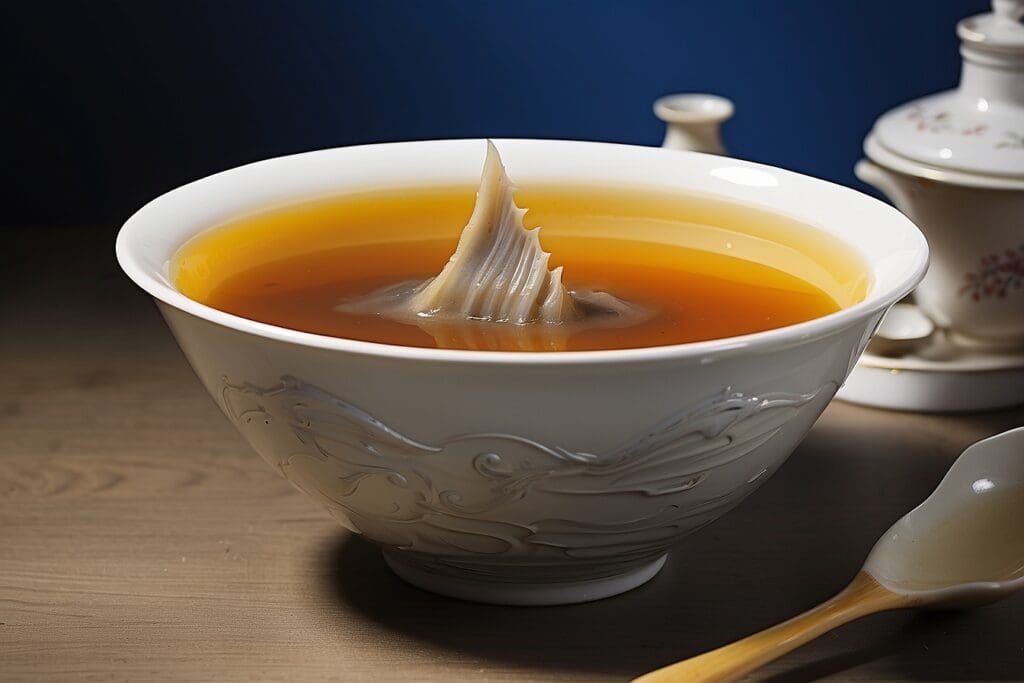It’s 11am and you want a nice light meal with many different flavor options. In my native country of China, this calls for only one thing – Dim Sum. This meal has also become more and more popular in the United States. One of the most highly demanded delicacies served in this meal is shark fin soup. The origins of this dish can be traced back to ancient China during the Sung Dynasty. The soup was served to show the king’s power, nobility, and wealth during banquets and public meals. Sharing shark fin soup became a symbol of sharing one’s wealth and wellness with others. As these traditions faded, the consumption of shark fin soup became more of an experience for foreigners and a comfort food for people native to the origins of the dish.
 2Shark fin soup is prepared by cooking dried shark fin with some sort of stock, usually chicken. The fin is typically chopped into a thin noodle consistency, but some choose to have the fin whole which tends to be extremely expensive.1 The fin is actually flavorless without the help of other ingredients in the soup, but because of tradition and exotic appeal, shark fin is one of the most prized cuts of meat in the world. Although delicious, eating this mammal comes with its environmental repercussions on top of animal rights concerns.
2Shark fin soup is prepared by cooking dried shark fin with some sort of stock, usually chicken. The fin is typically chopped into a thin noodle consistency, but some choose to have the fin whole which tends to be extremely expensive.1 The fin is actually flavorless without the help of other ingredients in the soup, but because of tradition and exotic appeal, shark fin is one of the most prized cuts of meat in the world. Although delicious, eating this mammal comes with its environmental repercussions on top of animal rights concerns.
Sharks have been the most feared top predator of the sea for as long as humankind has been studying the oceans. They have become a symbol of power and strength, and sometimes evil, but this predator is much more than that. Sharks are an essential part of the marine ecosystem and some scientists consider this apex predator a “keystone” species, which is a species whose removal could cause an ecosystem to collapse.3 Sharks control the large populations of other marine life to ensure the health and wellbeing of seagrass beds and the highly important but increasingly threatened overfishing ![]() due to the high demand of delicacies like shark fin soup, as well as the overfishing of other marine populations. The elimination of sharks has caused huge ecological problems, namely a disturbance in the trophic cascade, which is predator-prey pressure. For example, as shark populations are decreasing, the population of secondary consumers is on the rise. With this uncontrollable growth in the sharks’ prey populations, the prey of the prey is also on a rapid decline, like clams. Clams have had a significant population drop that has been attributed to the loss of shark populations.6 This is only one example of the importance of sharks to the oceanic ecosystems.
due to the high demand of delicacies like shark fin soup, as well as the overfishing of other marine populations. The elimination of sharks has caused huge ecological problems, namely a disturbance in the trophic cascade, which is predator-prey pressure. For example, as shark populations are decreasing, the population of secondary consumers is on the rise. With this uncontrollable growth in the sharks’ prey populations, the prey of the prey is also on a rapid decline, like clams. Clams have had a significant population drop that has been attributed to the loss of shark populations.6 This is only one example of the importance of sharks to the oceanic ecosystems.
There are over 350 types of sharks swimming in the ocean, each uniquely different from the others. Fins are harvested without discrimination because the fins of most sharks can be used to produce the specialty dish. One pound of dried shark fin can cost over $300 and there is no sign of this price dropping. With the increase of demand of shark fin soup, shark finning has become a new career for many Asian working men. The numbers of the sharks hunted is not certain because of the activity in the black market, but specialists estimate that 100 million sharks are killed for their fins annually.7 Not only is hunting these sharks damaging to the ecosystem, but the way they are being hunted is inhumane and unsustainable. Since the only valuable part of the shark is the fin, the fins are harvested and the rest of the shark is dropped back into the ocean. Sharks must swim in order to breath, so without their fins, they suffocate, drown, starve, or are eaten by other fish.8

https://greeniacs.10web.site/GreeniacsArticles/Wildlife/Species-Endangered.html”>endangered ![]() , and their status is quickly declining.10 Hunters do not care what kind of shark they are harvesting, as long as they can get the valuable fins. In an experiment conducted in the U.S., 32 shark fin soup samples from 14 different cities were tested to determine the species of shark used to make the delectable soup. The experiment found that 23 of the 32 sampled were from shark species that are considered to be endangered.11 This is extremely shocking and worrisome because the U.S. actually has regulations, while other countries like China and Japan do not. One can only imagine the amount of endangered shark fin used to feed their desire for this soup.
, and their status is quickly declining.10 Hunters do not care what kind of shark they are harvesting, as long as they can get the valuable fins. In an experiment conducted in the U.S., 32 shark fin soup samples from 14 different cities were tested to determine the species of shark used to make the delectable soup. The experiment found that 23 of the 32 sampled were from shark species that are considered to be endangered.11 This is extremely shocking and worrisome because the U.S. actually has regulations, while other countries like China and Japan do not. One can only imagine the amount of endangered shark fin used to feed their desire for this soup.
There are substitutes for this expensive and exquisite dish, but many want the authentic and traditional experience and are willing to pay more for it. However, it is not only the monetary cost that one should think about before consuming shark fin soup. The money that one pays to eat this delicacy is going to support an industry that runs on greed – no matter how many regulations are put up, if the demand is there, shark finning will continue to ravage the planet. This will negatively impact marine ecosystems everywhere and further threaten global biodiversity ![]() .
.
So before you order that shark fin soup, think about what your money is supporting. Is that really worth one bowl of soup?





